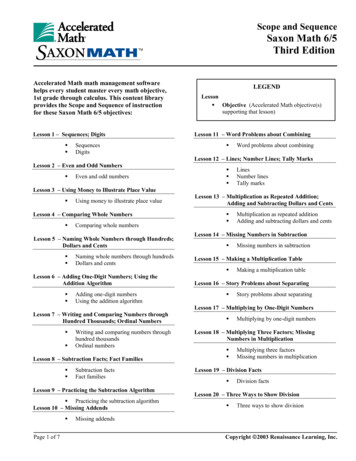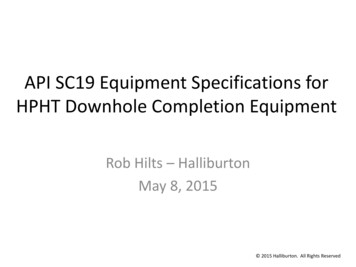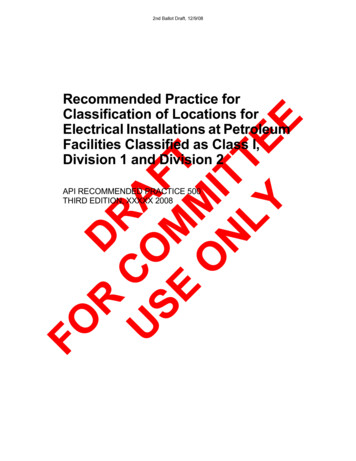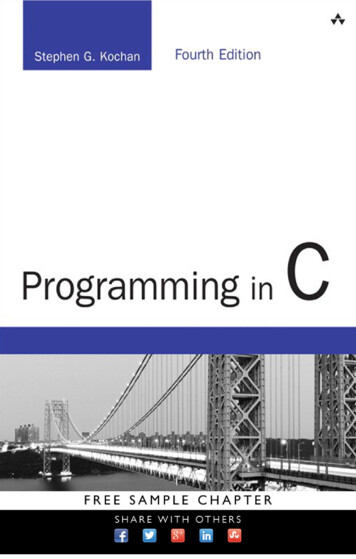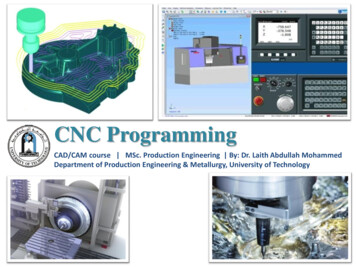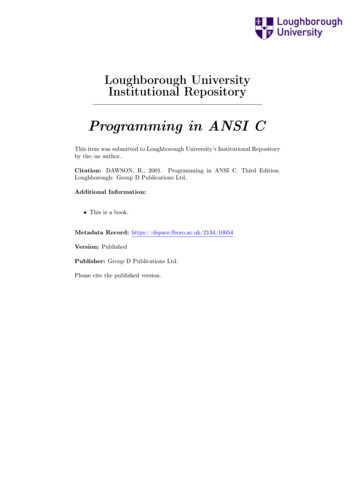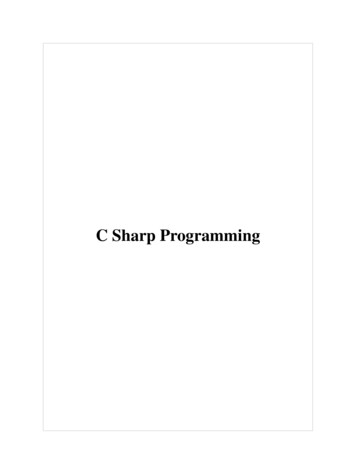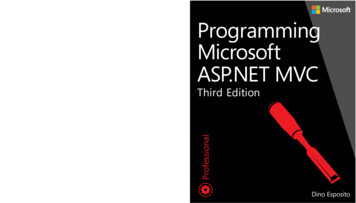
Transcription
Programming Microsoft ASP.NET MVCThird EditionGo deep into the architecture and features of ASP.NET MVC 5,and learn how to build web applications that work well on boththe desktop and mobile devices. Web development expert DinoEsposito takes you through the web framework’s Model-ViewController (MVC) design model, and covers the tools you needto cleanly separate business logic from the user interface. Ifyou’re an experienced web developer new to ASP.NET MVC, thispractical guide will get you going.About the AuthorDino Esposito is a well-known weband mobile development expert. Hespeaks at industry events, includingDevConnections and Microsoft TechEd,and contributes to MSDN Magazineand other publications. He has writtenseveral popular Microsoft Press books,including Architecting Mobile Solutionsfor the Enterprise.Discover how to: Build web applications that are easy to test and maintain Dive into the functions of controllers—the heart of an MVC site Explore the structure and behavior of a view engine Process a variety of input data using a custom model binder Automate the writing of input forms, and streamline validation Design websites for mobile devices, localization, and errorhandlingProgramming MicrosoftASP.NET MVCDevelop next-generation web applications withASP.NET MVCProgrammingMicrosoftASP.NET MVCThird Edition Provide security by implementing a membership and identity3(WURFL) to make sites mobile-friendlyDownload code samples at:editionhttp://aka.ms/programASP-NET MVC/filesEspositomicrosoft.com/mspressU.S.A. 49.99Canada 52.99Professionalsystem Inject script code into your site using JavaScript and jQuery Use Responsive Web Design and Wireless Universal Resource FiLe[Recommended]Programming/Microsoft ASP.NET MVCCelebrating 30 years!Dino Esposito
Programming MicrosoftASP.NET MVC, ThirdEditionDino Espositomvc5 book.indb 12/6/14 1:55 PM
Copyright 2014 Leonardo EspositoAll rights reserved. No part of the contents of this book may be reproduced or transmitted in any form or by anymeans without the written permission of the publisher.ISBN: 978-0-7356-8094-4Second Printing: April 2014Printed and bound in the United States of America.Microsoft Press books are available through booksellers and distributors worldwide. If you need support relatedto this book, email Microsoft Press Book Support at mspinput@microsoft.com. Please tell us what you think ofthis book at soft and the trademarks listed at ctualProperty/Trademarks/EN-US.aspx are trademarks of the Microsoft group of companies. All other marks are property oftheir respective owners.The example companies, organizations, products, domain names, email addresses, logos, people, places, andevents depicted herein are fictitious. No association with any real company, organization, product, domain name,email address, logo, person, place, or event is intended or should be inferred.This book expresses the author’s views and opinions. The information contained in this book is provided withoutany express, statutory, or implied warranties. Neither the author, O’Reilly Media, Inc., Microsoft Corporation, norits resellers, or distributors will be held liable for any damages caused or alleged to be caused either directly orindirectly by this book.Acquisitions and Developmental Editors: Russell Jones and Rachel RoumeliotisProduction Editor: Kristen BrownEditorial Production: Dianne Russell, Octal Publishing, Inc.Technical Reviewer: John MuellerCopyeditor: Bob Russell, Octal Publishing, Inc.Indexer: BIM Indexing ServicesCover Design: Twist Creative Seattle and Joel PanchotCover Composition: Ellie VolckhausenIllustrator: Rebecca Demarest
To Silvia, Francesco, Michela, and my back for sustaining me.—Dinomvc5 book.indb 32/6/14 1:55 PM
mvc5 book.indb 42/6/14 1:55 PM
mvc5 book.indb 62/6/14 1:55 PM
ContentsIntroduction . . . . . . . . . . . . . . . . . . . . . . . . . . . . . . . . . . . . . . . . . . . . . . . . . . . . . xiiiPart IASP.NET MVC FUNDAMENTALSChapter 1ASP.NET MVC controllers3Routing incoming requests. . . . . . . . . . . . . . . . . . . . . . . . . . . . . . . . . . . . . . . . . 4Simulating the ASP.NET MVC runtime. . . . . . . . . . . . . . . . . . . . . . . . . . 4The URL routing HTTP module. . . . . . . . . . . . . . . . . . . . . . . . . . . . . . . . 7Application routes. . . . . . . . . . . . . . . . . . . . . . . . . . . . . . . . . . . . . . . . . . . 9The controller class. . . . . . . . . . . . . . . . . . . . . . . . . . . . . . . . . . . . . . . . . . . . . . . 15Aspects of a controller . . . . . . . . . . . . . . . . . . . . . . . . . . . . . . . . . . . . . . 16Writing controller classes. . . . . . . . . . . . . . . . . . . . . . . . . . . . . . . . . . . . 17Processing input data. . . . . . . . . . . . . . . . . . . . . . . . . . . . . . . . . . . . . . . 22Producing action results. . . . . . . . . . . . . . . . . . . . . . . . . . . . . . . . . . . . . 25Summary. . . . . . . . . . . . . . . . . . . . . . . . . . . . . . . . . . . . . . . . . . . . . . . . . . . . . . . .30Chapter 2ASP.NET MVC views33The structure and behavior of a view engine . . . . . . . . . . . . . . . . . . . . . . . . 34The mechanics of a view engine. . . . . . . . . . . . . . . . . . . . . . . . . . . . . . 34Definition of the view template. . . . . . . . . . . . . . . . . . . . . . . . . . . . . . . 39HTML helpers. . . . . . . . . . . . . . . . . . . . . . . . . . . . . . . . . . . . . . . . . . . . . . . . . . . . 42Basic helpers. . . . . . . . . . . . . . . . . . . . . . . . . . . . . . . . . . . . . . . . . . . . . . . 43Templated helpers. . . . . . . . . . . . . . . . . . . . . . . . . . . . . . . . . . . . . . . . . . 48Custom helpers. . . . . . . . . . . . . . . . . . . . . . . . . . . . . . . . . . . . . . . . . . . . . 51The Razor view engine. . . . . . . . . . . . . . . . . . . . . . . . . . . . . . . . . . . . . . . . . . . . 54Inside the view engine. . . . . . . . . . . . . . . . . . . . . . . . . . . . . . . . . . . . . . . 54Designing a sample view . . . . . . . . . . . . . . . . . . . . . . . . . . . . . . . . . . . . 59Coding the view . . . . . . . . . . . . . . . . . . . . . . . . . . . . . . . . . . . . . . . . . . . . . . . . . 65Modeling the view. . . . . . . . . . . . . . . . . . . . . . . . . . . . . . . . . . . . . . . . . . 65Advanced features. . . . . . . . . . . . . . . . . . . . . . . . . . . . . . . . . . . . . . . . . . 70Summary. . . . . . . . . . . . . . . . . . . . . . . . . . . . . . . . . . . . . . . . . . . . . . . . . . . . . . . .73viimvc5 book.indb 72/6/14 1:55 PM
Chapter 3The model-binding architecture75The input model. . . . . . . . . . . . . . . . . . . . . . . . . . . . . . . . . . . . . . . . . . . . . . . . . 76Evolving from the Web Forms input processing . . . . . . . . . . . . . . . . 76Input processing in ASP.NET MVC. . . . . . . . . . . . . . . . . . . . . . . . . . . . . 78Model binding. . . . . . . . . . . . . . . . . . . . . . . . . . . . . . . . . . . . . . . . . . . . . . . . . . . 79Model-binding infrastructure . . . . . . . . . . . . . . . . . . . . . . . . . . . . . . . . 79The default model binder. . . . . . . . . . . . . . . . . . . . . . . . . . . . . . . . . . . . 80Customizable aspects of the default binder. . . . . . . . . . . . . . . . . . . . 91Advanced model binding . . . . . . . . . . . . . . . . . . . . . . . . . . . . . . . . . . . . . . . . . 93Custom type binders. . . . . . . . . . . . . . . . . . . . . . . . . . . . . . . . . . . . . . . . 93A sample DateTime model binder. . . . . . . . . . . . . . . . . . . . . . . . . . . . . 96Summary. . . . . . . . . . . . . . . . . . . . . . . . . . . . . . . . . . . . . . . . . . . . . . . . . . . . . . .101Chapter 4Input forms103General patterns of data entry. . . . . . . . . . . . . . . . . . . . . . . . . . . . . . . . . . . . 104A classic Select-Edit-Post scenario . . . . . . . . . . . . . . . . . . . . . . . . . . . 104Applying the Post-Redirect-Get pattern. . . . . . . . . . . . . . . . . . . . . . 112Automating the writing of input forms. . . . . . . . . . . . . . . . . . . . . . . . . . . . . 117Predefined display and editor templates. . . . . . . . . . . . . . . . . . . . . . 117Custom templates for model data types. . . . . . . . . . . . . . . . . . . . . . 125Input validation. . . . . . . . . . . . . . . . . . . . . . . . . . . . . . . . . . . . . . . . . . . . . . . . . 130Using data annotations. . . . . . . . . . . . . . . . . . . . . . . . . . . . . . . . . . . . . 130Advanced data annotations. . . . . . . . . . . . . . . . . . . . . . . . . . . . . . . . . 135Self-validation. . . . . . . . . . . . . . . . . . . . . . . . . . . . . . . . . . . . . . . . . . . . . 142Summary. . . . . . . . . . . . . . . . . . . . . . . . . . . . . . . . . . . . . . . . . . . . . . . . . . . . . . .146Part IIASP.NET MVC SOFTWARE DESIGNChapter 5Aspects of ASP.NET MVC applications151ASP.NET intrinsic objects. . . . . . . . . . . . . . . . . . . . . . . . . . . . . . . . . . . . . . . . . 151HTTP response and SEO. . . . . . . . . . . . . . . . . . . . . . . . . . . . . . . . . . . . 152Managing the session state. . . . . . . . . . . . . . . . . . . . . . . . . . . . . . . . . 155Caching data. . . . . . . . . . . . . . . . . . . . . . . . . . . . . . . . . . . . . . . . . . . . . . 157viiimvc5 book.indb 8Contents2/6/14 1:55 PM
Error handling. . . . . . . . . . . . . . . . . . . . . . . . . . . . . . . . . . . . . . . . . . . . . . . . . . 163Handling program exceptions. . . . . . . . . . . . . . . . . . . . . . . . . . . . . . . 163Global error handling. . . . . . . . . . . . . . . . . . . . . . . . . . . . . . . . . . . . . . 169Dealing with missing content. . . . . . . . . . . . . . . . . . . . . . . . . . . . . . . . 172Localization . . . . . . . . . . . . . . . . . . . . . . . . . . . . . . . . . . . . . . . . . . . . . . . . . . . . 175Using localizable resources . . . . . . . . . . . . . . . . . . . . . . . . . . . . . . . . . 175Dealing with localizable applications. . . . . . . . . . . . . . . . . . . . . . . . . 182Summary. . . . . . . . . . . . . . . . . . . . . . . . . . . . . . . . . . . . . . . . . . . . . . . . . . . . . . .187Chapter 6Securing your application189Security in ASP.NET MVC. . . . . . . . . . . . . . . . . . . . . . . . . . . . . . . . . . . . . . . . . 189Authentication and authorization. . . . . . . . . . . . . . . . . . . . . . . . . . . . 190Separating authentication from authorization. . . . . . . . . . . . . . . . . 192Implementing a membership system. . . . . . . . . . . . . . . . . . . . . . . . . . . . . . 195Defining a membership controller. . . . . . . . . . . . . . . . . . . . . . . . . . . 196The Remember-Me feature and Ajax. . . . . . . . . . . . . . . . . . . . . . . . . 204External authentication services. . . . . . . . . . . . . . . . . . . . . . . . . . . . . . . . . . . 207The OpenID protocol. . . . . . . . . . . . . . . . . . . . . . . . . . . . . . . . . . . . . . . 208Authenticating via social networks. . . . . . . . . . . . . . . . . . . . . . . . . . . 215Summary. . . . . . . . . . . . . . . . . . . . . . . . . . . . . . . . . . . . . . . . . . . . . . . . . . . . . . .223Chapter 7Design considerations for ASP.NET MVC controllers 225Shaping up your controller. . . . . . . . . . . . . . . . . . . . . . . . . . . . . . . . . . . . . . . 226Choosing the right stereotype. . . . . . . . . . . . . . . . . . . . . . . . . . . . . . . 226Fat-free controllers. . . . . . . . . . . . . . . . . . . . . . . . . . . . . . . . . . . . . . . . . 230Connecting the presentation and back end. . . . . . . . . . . . . . . . . . . . . . . . .237The Layered Architecture pattern. . . . . . . . . . . . . . . . . . . . . . . . . . . . 237Injecting data and services in layers. . . . . . . . . . . . . . . . . . . . . . . . . . 244Gaining control of the controller factory. . . . . . . . . . . . . . . . . . . . . . 250Summary. . . . . . . . . . . . . . . . . . . . . . . . . . . . . . . . . . . . . . . . . . . . . . . . . . . . . . .253ixmvc5 book.indb 92/6/14 1:55 PM
Chapter 8Customizing ASP.NET MVC controllers255The extensibility model of ASP.NET MVC. . . . . . . . . . . . . . . . . . . . . . . . . . . 255The provider-based model. . . . . . . . . . . . . . . . . . . . . . . . . . . . . . . . . . 256The Service Locator pattern. . . . . . . . . . . . . . . . . . . . . . . . . . . . . . . . . 259Adding aspects to controllers. . . . . . . . . . . . . . . . . . . . . . . . . . . . . . . . . . . . . 263Action filters. . . . . . . . . . . . . . . . . . . . . . . . . . . . . . . . . . . . . . . . . . . . . . 263Gallery of action filters. . . . . . . . . . . . . . . . . . . . . . . . . . . . . . . . . . . . . 267Special filters. . . . . . . . . . . . . . . . . . . . . . . . . . . . . . . . . . . . . . . . . . . . . . 274Building a dynamic loader filter . . . . . . . . . . . . . . . . . . . . . . . . . . . . . 279Action result types. . . . . . . . . . . . . . . . . . . . . . . . . . . . . . . . . . . . . . . . . . . . . . 285Built-in action result types. . . . . . . . . . . . . . . . . . . . . . . . . . . . . . . . . . 285Custom result types. . . . . . . . . . . . . . . . . . . . . . . . . . . . . . . . . . . . . . . . 290Summary. . . . . . . . . . . . . . . . . . . . . . . . . . . . . . . . . . . . . . . . . . . . . . . . . . . . . . .299Chapter 9Testing and testability in ASP.NET MVC301Testability and design. . . . . . . . . . . . . . . . . . . . . . . . . . . . . . . . . . . . . . . . . . . .302DfT . . . . . . . . . . . . . . . . . . . . . . . . . . . . . . . . . . . . . . . . . . . . . . . . . . . . . . 302Loosen up your design. . . . . . . . . . . . . . . . . . . . . . . . . . . . . . . . . . . . . 304The basics of unit testing. . . . . . . . . . . . . . . . . . . . . . . . . . . . . . . . . . . . . . . . . 308Working with a test harness. . . . . . . . . . . . . . . . . . . . . . . . . . . . . . . . . 309Aspects of testing. . . . . . . . . . . . . . . . . . . . . . . . . . . . . . . . . . . . . . . . . . 313Testing your ASP.NET MVC code. . . . . . . . . . . . . . . . . . . . . . . . . . . . . . . . . . 319Which part of your code should you test?. . . . . . . . . . . . . . . . . . . . . 319Unit testing ASP.NET MVC code. . . . . . . . . . . . . . . . . . . . . . . . . . . . . 322Dealing with dependencies. . . . . . . . . . . . . . . . . . . . . . . . . . . . . . . . . 326Mocking the HTTP context. . . . . . . . . . . . . . . . . . . . . . . . . . . . . . . . . . 328Summary. . . . . . . . . . . . . . . . . . . . . . . . . . . . . . . . . . . . . . . . . . . . . . . . . . . . . . .335Chapter 10 An executive guide to Web API337The whys and wherefores of Web API. . . . . . . . . . . . . . . . . . . . . . . . . . . . . . 337The need for a unified HTTP API. . . . . . . . . . . . . . . . . . . . . . . . . . . . . 338MVC controllers vs. Web API. . . . . . . . . . . . . . . . . . . . . . . . . . . . . . . . 339xmvc5 book.indb 10Contents2/6/14 1:55 PM
Putting Web API to work. . . . . . . . . . . . . . . . . . . . . . . . . . . . . . . . . . . . . . . . . 341Designing a RESTful interface . . . . . . . . . . . . . . . . . . . . . . . . . . . . . . . 342Expected method behavior. . . . . . . . . . . . . . . . . . . . . . . . . . . . . . . . . 346Using the Web API. . . . . . . . . . . . . . . . . . . . . . . . . . . . . . . . . . . . . . . . . 348Designing an RPC-oriented Interface. . . . . . . . . . . . . . . . . . . . . . . . . 352Security considerations. . . . . . . . . . . . . . . . . . . . . . . . . . . . . . . . . . . . . 355Negotiating the response format. . . . . . . . . . . . . . . . . . . . . . . . . . . . . . . . . .359The ASP.NET MVC approach . . . . . . . . . . . . . . . . . . . . . . . . . . . . . . . . 359How content negotiation works in Web API. . . . . . . . . . . . . . . . . . . 360Summary. . . . . . . . . . . . . . . . . . . . . . . . . . . . . . . . . . . . . . . . . . . . . . . . . . . . . . .363Part IIIMOBILE CLIENTSChapter 11 Effective JavaScript367Revisiting the JavaScript language. . . . . . . . . . . . . . . . . . . . . . . . . . . . . . . . . 368Language basics. . . . . . . . . . . . . . . . . . . . . . . . . . . . . . . . . . . . . . . . . . . 368Object-orientation in JavaScript. . . . . . . . . . . . . . . . . . . . . . . . . . . . . 373jQuery’s executive summary. . . . . . . . . . . . . . . . . . . . . . . . . . . . . . . . . . . . . . 377DOM queries and wrapped sets. . . . . . . . . . . . . . . . . . . . . . . . . . . . . 377Selectors . . . . . . . . . . . . . . . . . . . . . . . . . . . . . . . . . . . . . . . . . . . . . . . . . 379Events. . . . . . . . . . . . . . . . . . . . . . . . . . . . . . . . . . . . . . . . . . . . . . . . . . . . 384Aspects of JavaScript programming. . . . . . . . . . . . . . . . . . . . . . . . . . . . . . . 387Unobtrusive code. . . . . . . . . . . . . . . . . . . . . . . . . . . . . . . . . . . . . . . . . . 387Reusable packages and dependencies. . . . . . . . . . . . . . . . . . . . . . . . 388Script and resource loading. . . . . . . . . . . . . . . . . . . . . . . . . . . . . . . . . 391Bundling and minification . . . . . . . . . . . . . . . . . . . . . . . . . . . . . . . . . . 394Summary. . . . . . . . . . . . . . . . . . . . . . . . . . . . . . . . . . . . . . . . . . . . . . . . . . . . . . .397Chapter 12 Making websites mobile-friendly399Technologies for enabling mobile on sites. . . . . . . . . . . . . . . . . . . . . . . . . . 399HTML5 for the busy developer. . . . . . . . . . . . . . . . . . . . . . . . . . . . . . 400RWD. . . . . . . . . . . . . . . . . . . . . . . . . . . . . . . . . . . . . . . . . . . . . . . . . . . . . 407jQuery Mobile’s executive summary. . . . . . . . . . . . . . . . . . . . . . . . . . 413Twitter Bootstrap at a glance. . . . . . . . . . . . . . . . . . . . . . . . . . . . . . . . 423Contentsmvc5 book.indb 11xi2/6/14 1:55 PM
Adding mobile capabilities to an existing site. . . . . . . . . . . . . . . . . . . . . . . 430Routing users to the correct site. . . . . . . . . . . . . . . . . . . . . . . . . . . . . 431From mobile to devices. . . . . . . . . . . . . . . . . . . . . . . . . . . . . . . . . . . . . 436Summary. . . . . . . . . . . . . . . . . . . . . . . . . . . . . . . . . . . . . . . . . . . . . . . . . . . . . . .437Chapter 13 Building sites for multiple devices439Understanding display modes in ASP.NET MVC. . . . . . . . . . . . . . . . . . . . . 440Separated mobile and desktop views. . . . . . . . . . . . . . . . . . . . . . . . . 440Rules for selecting the display mode. . . . . . . . . . . . . . . . . . . . . . . . . 442Adding custom display modes. . . . . . . . . . . . . . . . . . . . . . . . . . . . . . .443Introducing the WURFL database . . . . . . . . . . . . . . . . . . . . . . . . . . . . . . . . . 446Structure of the repository. . . . . . . . . . . . . . . . . . . . . . . . . . . . . . . . . . 447Essential WURFL capabilities . . . . . . . . . . . . . . . . . . . . . . . . . . . . . . . . 451Using WURFL with ASP.NET MVC display modes. . . . . . . . . . . . . . . . . . . . 454Configuring the WURFL framework. . . . . . . . . . . . . . . . . . . . . . . . . . 454Detecting device capabilities. . . . . . . . . . . . . . . . . . . . . . . . . . . . . . . . 456Using WURFL-based display modes. . . . . . . . . . . . . . . . . . . . . . . . . . 459The WURFL cloud API. . . . . . . . . . . . . . . . . . . . . . . . . . . . . . . . . . . . . . 464Why you should consider server-side solutions . . . . . . . . . . . . . . . . . . . . . 466Summary. . . . . . . . . . . . . . . . . . . . . . . . . . . . . . . . . . . . . . . . . . . . . . . . . . . . . . .467Index469About the author495What do you think of this book? We want to hear from you!Microsoft is interested in hearing your feedback so we can continually improve ourbooks and learning resources for you. To participate in a brief online survey, please visit:microsoft.com/learning/booksurveyxiimvc5 book.indb 12Contents2/6/14 1:55 PM
IntroductionGet your facts first, and then you can distort them as much as youplease.—Mark TwainASP.NET was devised in the late 1990s at a time when many companies in variousindustry sectors were rapidly discovering the Internet. The primary goal of ASP.NETwas to make it possible for developers to build applications quickly and effectively without having to deal with low-level details such as HTTP, HTML, and JavaScript intricacies.That was exactly what the community loudly demanded at that time. ASP.NET is whatMicrosoft delivered to address this request, exceeding expectations by a large extent.Today, more than ten years later, ASP.NET is showing signs of age, and many startedeven questioning the real necessity of having a web framework at all. It’s an amazingtime, and several options exist. There are Web Forms and ASP.NET MVC applications,and then there are more JavaScript-intensive client applications (single-page applications) that just use a server-side back end for delivering the basic layout of the fewpages they actually expose and for ad hoc services such as bundling.Curiously, with the Web Forms paradigm, you can still write functional applicationseven though ASP.NET MVC addresses more closely the present needs of developers.The most common scenario of Web Forms is applications for which you focus onpresenting data and use some third-party high-quality suite of controls for that. ASP.NETMVC is for everything else, including the scaffolding of client-side single-page applications.The way web applications are changing proves that ASP.NET MVC probably failed toreplace ASP.NET Web Forms in the heart of many developers, but it was the right choiceand qualifies to be the ideal web platform for any application that needs a back end ofsome substance; in particular (as I see things), web applications that aim at being multidevice functional. And yes, that likely means all web applications in less than two years.Switching to ASP.NET MVC is more than ever the natural follow-up for ASP.NETdevelopers.xiiimvc5 book.indb 132/6/14 1:55 PM
Who should read this bookOver the years, quite a few people have read quite a few books and articles of mine.These readers are already aware that I’m not good at writing step-by-step, referencestyle books, in the similar manner that I'm unable to teach the same class twice, runningtopics in the same order and showing the same examples.This book is not for absolute beginners; but I do feel it is a book for all the others, including those who are still fairly new to ASP.NET MVC. The higher your level ofcompetency and expertise, the less you can expect to find here that adds value in yourparticular case. However, this book benefits from a few years of real-world practice; soI’m sure it has a lot of solutions that might also appeal to the experts, particularly withrespect to mobile devices.If you use ASP.NET MVC, I’m confident that you’ll find something in this book thatmakes it worthwhile.AssumptionsThis book expects that you have at least a minimal understanding of ASP.NET development.Who should not read this bookIf you’re looking for a step-by-step guide to ASP.NET MVC, this is not the ideal bookfor you.Organization of this bookThis book is divided into three sections. Part I, “ASP.NET MVC fundamentals,” provides aquick overview of the foundation of ASP.NET and its core components. Part II, “ASP.NETMVC software design,” focuses on common aspects of web applications and specificdesign patterns and best practices. Finally, Part III, “Mobile clients,” is about JavaScriptand mobile interfaces.xiv Introductionmvc5 book.indb 142/6/14 1:55 PM
System requirementsYou preferably have the following software installed in order to run the examples presented in this book: One of the following operating systems: Windows 8/8.1, Windows 7, WindowsVista with Service Pack 2 (except Starter Edition), Windows XP with Service Pack3 (except Starter Edition), Windows Server 2008 with Service Pack 2, WindowsServer 2003 with Service Pack 2, or Windows Server 2003 R2Microsoft Visual Studio 2013, any edition (multiple downloads might be required if you’re using Express Edition products)Microsoft SQL Server 2012 Express Edition or higher, with SQL Server Management Studio 2012 Express or higher (included with Visual Studio; Express Editions require a separate download)Depending on your Windows configuration, you might require Local Administratorrights to install or configure Visual Studio 2013 and SQL Server 2012 products.Code samplesMost of the chapters in this book include exercises with which you can interactively tryout new material learned in the main text. You can download all sample projects, inboth their pre-exercise and post-exercise formats, from the following page:http://aka.ms/programASP-NET MVC/filesFollow the instructions to download the asp-net-mvc-examples.zip file.Installing the code samplesPerform the following steps to install the code samples on your computer so that youcan use them with the exercises in this book.1.Unzip the asp-net-mvc-examples.zip file that you downloaded from the book’swebsite (name a specific directory along with directions to create it, if necessary).2.If prompted, review the displayed end-user license agreement. If you accept theterms, select the Accept option, and then click Next.Introduction xvmvc5 book.indb 152/6/14 1:55 PM
Note If the license agreement doesn’t appear, you can access it from thesame webpage from which you downloaded the asp-net-mvc-examples.zip file.Using the code samplesThe folder created by the Setup.exe program contains one subfolder for each chapter.In turn, each chapter might contain additional subfolders. All examples are organized ina single Visual Studio 2013 solution. You open the solution file in Visual Studio 2013 andnavigate through the examples.Errata & book supportWe’ve made every effort to ensure the accuracy of this book and its companion content. Any errors that have been reported since this book was published are listed on ourMicrosoft Press site:http://aka.ms/programASP-NET MVC/errataIf you find an error that is not already listed, you can report it to us through thesame page.If you need additional support, email Microsoft Press Book Support at mspinput@microsoft.com.Please note that product support for Microsoft software is not offered through theaforementioned addresses.We want to hear from youAt Microsoft Press, your satisfaction is our top priority, and your feedback our mostvaluable asset. Please tell us what you think of this book at:http://aka.ms/tellpressThe survey is short, and we read every one of your comments and ideas. Thanks inadvance for your input!Stay in touchLet’s keep the conversation going! We’re on Twitter: http://twitter.com/MicrosoftPressmvc5 book.indb 162/6/14 1:55 PM
CHAPTER 3The model-binding architectureIt does not matter how slowly you go, so long as you do not stop.—ConfuciusBy default, the Microsoft Visual Studio standard project template for ASP.NET MVC applicationsincludes a Models folder. If you look around for some guidance on how to use it and information about its intended role, you'll quickly reach the conclusion that the Models folder exists to storemodel classes. Fine, but which model is it for? Or, more precisely, what’s the definition of a “model”?I like to say that “model” is the most misunderstood idea in the history of software. As a concept,it needs to be expanded a bit to make sense in modern software. When the Model-View-Controller(MVC) pattern was introduced, software engineering was in its infancy, and applications were muchsimpler than today. Nobody really felt the need to break up the concept of model into smaller pieces.Such smaller pieces, however, existed.In general, I find at least two distinct models: the domain model and the view model. The formerdescribes the data you work with in the middle tier and is expected to provide a faithful representation of the entities and relationships that populate the business domain. These entities are typicallypersisted by the data-access layer and consumed by services that implement business processes. Thisdomain model pushes a vision of data that is, in general, distinct and likely different from the visionof data you find in the presentation layer. The view model just describes the data that is being workedon in the presentation layer. A good example might be the canonical Order entity. There might beuse-cases in which the application needs to present a collection of orders to users but not all properties are required. For example, you might need ID, date, and total, and likely a distinct containerclass—a data-transfer object (DTO).Having said that, I agree with anyone who points out that not every application needs a neat separation between the object models used in the presentation and business layers. You might decide thatfor your own purposes the two models nearly coincide, but you should always recognize the existenceof two distinct models that operate in two distinct layers.This chapter introduces a third type of model that, although hidden for years in the folds of theASP.NET Web Forms runtime, stands on its own in ASP.NET MVC: the input model. The input modelrefers to the model through which posted data is exposed to controllers and subsequently receivedby the application. The input model defines the DTOs the application uses to receive data from inputforms.75mvc5 book.indb 752/6/14 1:56 PM
Note Yet another flavor of model not mentioned here is the data model or the (mostly relational) model used to persist data.The input modelChapter 1, “ASP.NET MVC controllers,” discusses request routing and the overall structure of controllermethods. Chapter 2, “ASP.NET MVC views,” explores views as the primary result of action process
ASP.NET MVC Go deep into the architecture and features of ASP.NET MVC 5, and learn how to build web applications that work well on both the desktop and mobile devices. Web development expert Dino Esposito takes you through the web framework’s Model-View- Controller (
